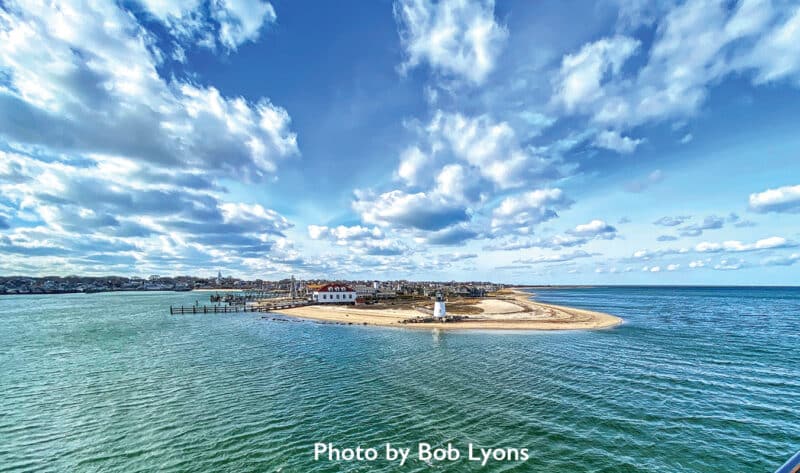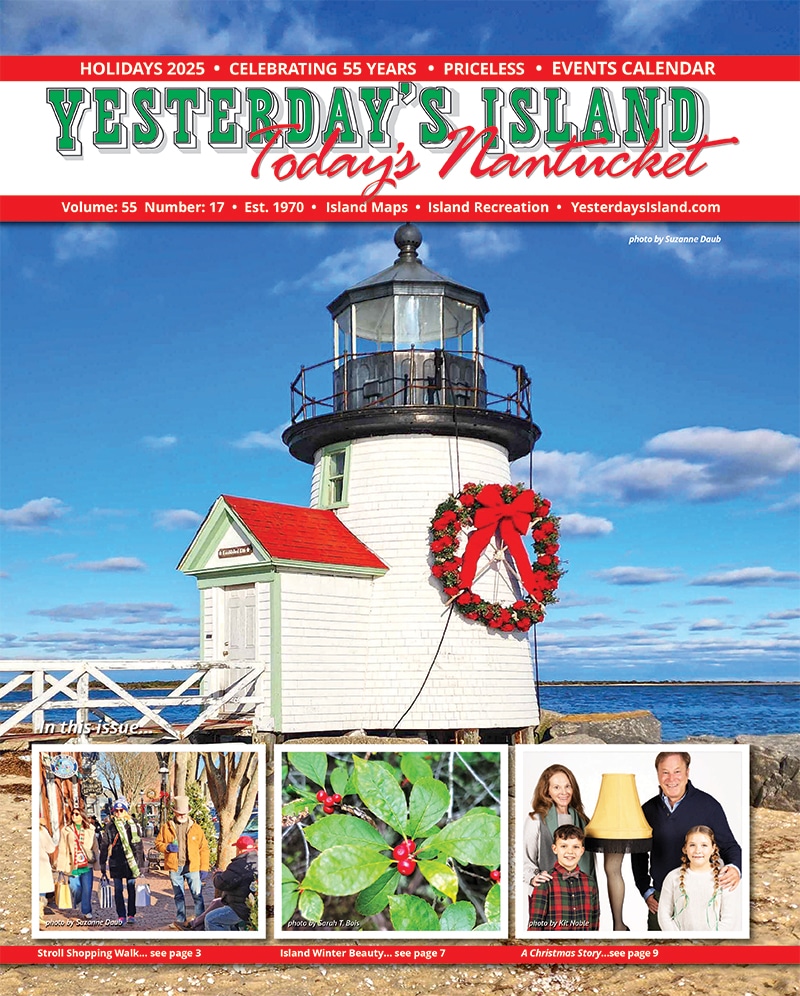by Dr. Sarah Treanor Bois, PhD
Director of Research & Education at the Linda Loring Nature Foundation
Living on an island surrounded by the sea, there is no escaping the effects of climate change. Others living inland may be able to bury their heads in the sand, but on Nantucket sea level rise, erosion, storm surge, and flooding are all very real impacts that we experience regularly.
It’s one thing to be aware of climate change and its impacts on the community: it’s another thing to plan for its effects and to take action. Nantucket has long been a community that works together to solve issues and protect the island and its residents. Nantucket is resilient: with the climate projections, we need to be a little more pro-active to stay resilient in the face of such change.
To work on issues specifically related to climate change impacts on our island, the Coastal Resilience Advisory Committee (CRAC) was established by Nantucket’s Select Board on April 24, 2019. Around the same time, the role of Coastal Resiliency Coordinator was created to coordinate efforts among various town departments and boards as well as to work directly with the CRAC. Some aspects of climate change and resiliency had previously been addressed by other departments. Significant storms, erosion, and floodwaters were often responded to from an emergency standpoint within an immediate timeframe by the Natural Resources Department, the Harbormaster, the US Coast Guard, and others, depending on the issue. Short-term planning was found within the Hazard Mitigation Plan, the Nantucket Harbor Plan, and the Resilient Nantucket Design Guidelines and Resilience Toolkit. But with the current and projected climate change impacts facing our community, the CRAC was formed to help address these issues. It was a show of commitment by the Select Board as to the importance of planning for the future and all the projected impacts.
The mission of the CRAC is stated as follows: “This committee will work with the Coastal Resilience Coordinator in the development, oversight, and implementation of a Coastal Resilience Plan for the Town of Nantucket to address the impact of climate change and sea level rise. The Plan shall address planning across the system-wide needs of the community and include social, cultural, and economic needs, infrastructure needs, and needs of the natural environment. The preservation of historical landmarks shall be a component of the Plan.”
After years of working with consultants and input from the community, the Coastal Resiliency Plan (CRP) for the Town was adopted in 2021 by the Nantucket Select Board. With the adoption of the plan, the goals of CRAC shifted a bit. The detailed “statement of purpose” are at nantucket-ma.gov/1391/Coastal-Resilience- Advisory-Committee). Basically, it includes working with the plan and recommending priorities for CR projects as well as listening to community feedback and integrating CR with other Town departments and plans among other tasks.
So who’s on the committee? The 11-member board consists of 3 at-large members appointed by the Select Board. If members of the public are interested in being on CRAC, one of the three at-large spots is filled each year. The other 8 members are representatives from various organizations and town boards that have a stake in coastal resiliency. These are the Nantucket Conservation Foundation (the largest landowner on the island), the Nantucket Land Bank, the Harbor and Shellfish Advisory Board, the Conservation Commission, the Advisory Committee of Non-Voting Tax Payers, the Planning Board, and the Capital Program Committee.
CRAC is an advisory committee: this is an important distinction from regulatory boards like the HDC, the Conservation Commission, and others, which can set policy and make regulatory decisions. Because it is not a regulatory body, CRAC has no by-laws or regulations to enforce or to base decisions on: they offer recommendations to the Select Board. In addition, if the Select Board has a coastal resilience topic that they want CRAC to weigh in on, CRAC will do so and present it at a Select Board meeting. CRAC advises the Select Board on issues surrounding coastal resiliency—it is the Select Board who ultimately decides to use or act on all, none, or portions of CRAC recommendations.
When I asked CR Coordinator Leah Hill what she wants the community to know about CRAC, she said: “CRAC meets every 2nd and 4th Tuesday of the month, and it is a public meeting so members of the public can attend to learn more about coastal resiliency, the CRP, and ask questions or comment on agenda topics. Right now, CRAC has a property owner survey out which can be found at nantucket-ma.gov/CRAC — the survey only takes about 5 minutes, and responses will help the committee develop informational materials to support homeowners in adopting best resiliency practices to mitigate coastal hazards on their property. CRAC is here to shine a light on coastal resiliency and engage and help the community become prepared and more resilient to current and future coastal risks (stormwater flooding, coastal storm flooding, sea level rise, erosion, groundwater table rise).”
If people have comments or questions about any CRAC actions or resilience projects, CRAC offers a platform for public engagement and public feedback on projects, as well as in public comment in each meeting. With guidance from the Select Board, today, the CRAC works on outreach about CR issues as well as focusing on moving forward priorities from the CR plan.
Within the CRP are two recommendations that CRAC is championing for implementation. The first is #1-1 Community Outreach on Property Owner Resilience Best Practices, which they have been working on through a variety of outlets. They have embarked on a social media campaign using the Natural Resources Department’s accounts (Instagram @nrdack; Facebook: Town of Nantucket Natural Resources Department), where a coastal resiliency related topic is posted every Thursday. They have developed a brochure on coastal risks for real estate agents and prospective buyers that explains the four coastal risks on-island and how to use different maps and models to see if a property faces those risks currently or if they are predicted in the future. In addition, it has helpful questions to ask related to coastal risks before a property is purchased. At the Town’s Coastal Resilience webpage—nantucket-ma.gov/crp—there is a Homeowners & Property Owners tile that links to more details.
The second recommendation is #1-14, which is updating locally adopted sea level rise scenarios and best available flood hazard data which CRAC and the Select Board has updated and adopted twice since the CRP was endorsed. It states “The CRAC recommends all Town Departments, Boards, Commissions and Committees and any service providers, contracted engineers and consultants be aware of and use the NOAA High Scenario to accommodate current storm surge as well as Sea Level Rise in their decisions, deliberations, and planning. These data are periodically updated by NOAA and will be posted on the CRAC page on the Town’s website.” CRAC wants to be proactive and to plan for the worst and hope for the best. Right now, CRAC is looking at all of the local regulatory boards and commissions to see how and if coastal resiliency can be integrated into regulations and by-laws. They are focusing on CRP rec #1-2 Updating Zoning By-laws to encourage resilience design and limit investment in high-risk areas.”
When thinking about accomplishments of the CRAC thus far, Leah Hill had a hard time narrowing down the list. That’s a good sign for all the work the committee has done. “There are a lot (of accomplishments) to choose from, but CRAC was instrumental in developing the Town’s first Coastal Resilience Plan, which is extremely important, comprehensive, and is island-wide. One of the bigger accomplishments on behalf of CRAC is getting the CRP rec #2-6 Downtown Flood Barrier Phase 1 underway. Shortly after the CRP was endorsed by the Select Board, CRAC voted to have the Downtown Flood Barrier as their highest priority project. It took two rounds of grant applications to the Massachusetts Office of Coastal Zone Management, but that is now an active project and real ‘feather in the cap’ for CRAC accomplishments.”
For my part, I have been on the Coastal Resiliency Advisory Committee as an at-large member since the committee started in 2019. We have worked hard to learn much from other communities dealing with issues of resiliency. I am proud of the work we have accomplished thus far, but we didn’t create a plan to sit on the shelf—the CR plan is a “living document” that needs to change as conditions, information, and science change. Everyone in our community will be (and is being) affected by climate change impacts. We need to hear all voices to help guide priorities and make changes.
If you want to learn more, stay informed about island resiliency issues, and provide input on various projects, attend a CRAC meeting via Zoom on each 2nd and 4th Tuesdays of every month (the agendas and links will be posted online at nantucket-ma.gov/1391/Coastal-Resilience-Advisory-Committee ). We hope to see you there.



